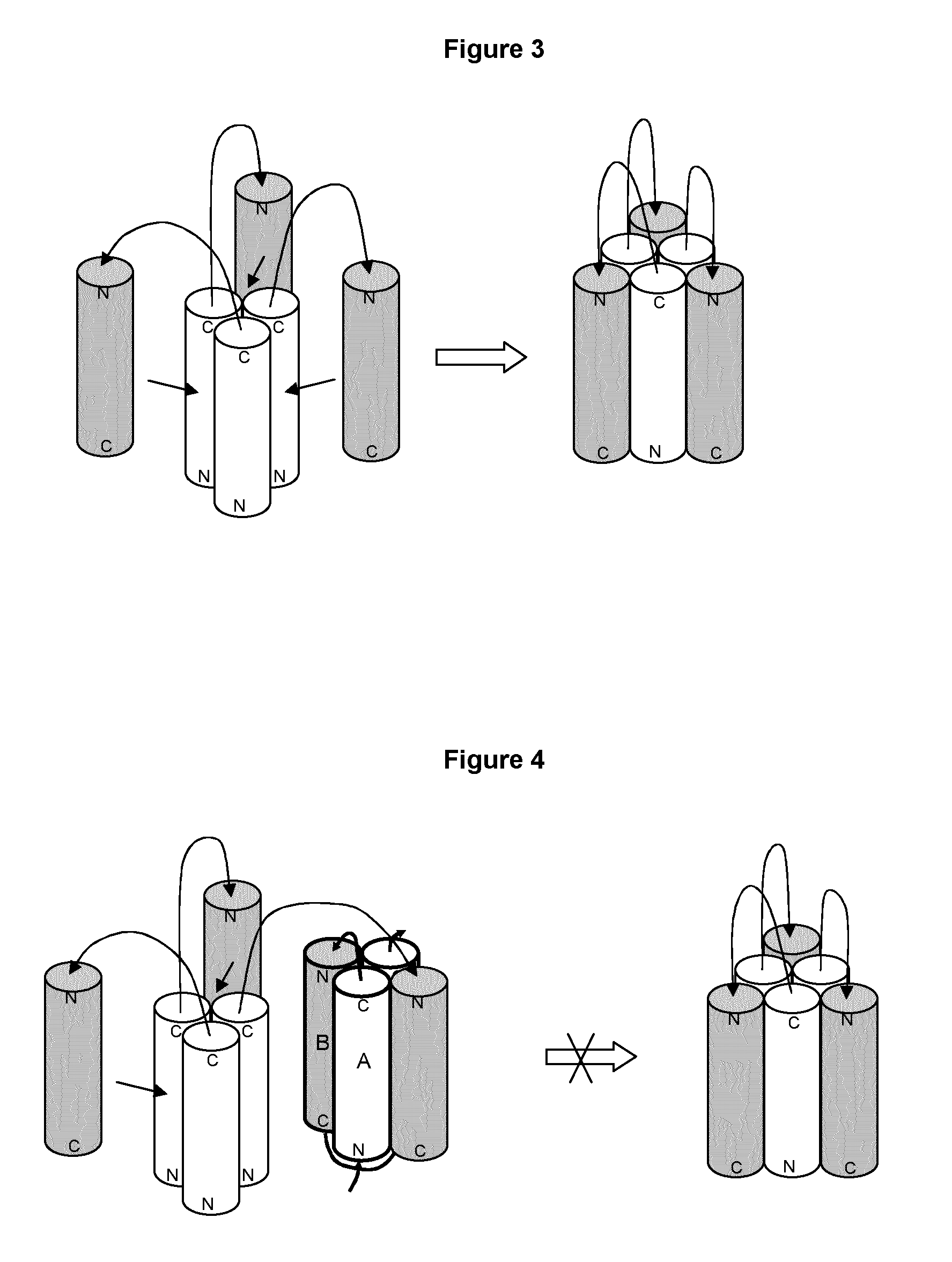Alphabodies specifically binding to class-i viral fusion proteins and methods for producing the same
a technology of fusion protein and specific binding, which is applied in the direction of peptide/protein ingredients, drug compositions, peptides, etc., can solve the problems of numerous side effects, nausea, vomiting, skin rashes, etc., and achieves high affinity and specificity, insensitive to heat and other factors, and is extremely (thermo)stable
- Summary
- Abstract
- Description
- Claims
- Application Information
AI Technical Summary
Benefits of technology
Problems solved by technology
Method used
Image
Examples
example 1
HIV-1 gp41 N-Trimer Groove-Grafted Alphabodies
[0262]The aim of the present example is to demonstrate a practically feasible method to generate a gp41 N-trimer-mimicking Alphabody.
[0263]Applicants have analyzed the crystallographically determined structure of the 5-helix bundle in complex with the Fab antigen-binding domain D5 (Root et al. Science 2001, 291:884-888; PDB structure 2CMR). FIG. 7, panel A, shows a schematic representation of the N-trimer part of the 5-helix bundle.
[0264]According to the authors (Root et al., ibid), the N-trimer groove residues that constitute the interface with HR2 are located at heptad e- and g-positions. However, according to our own structural analysis, at least the b- and c-residues should be taken into account as well. Therefore, when grafting gp41 groove residues onto structurally equivalent positions in an Alphabody, the set amino acid residues located at b-, c-, e- and g-positions are to be considered, unlike what is suggested in FIG. 4 of Root ...
example 2
gp41 HR2 Binding Site-Grafted Alphabodies
[0270]The aim of the present example is to demonstrate a practically feasible method to generate an Alphabody that mimics the HR2 surface that makes contact with an N-trimer groove in a 6-helix bundle of HIV-1 gp41 (HR2 binding site-grafted or HR2-mimicking Alphabody). Essentially the same strategy was followed as in EXAMPLE 1, with specific modifications as discussed hereinafter.
[0271]FIG. 7, panel A, lower helical wheel, shows a schematic representation of an HR2 helix of HIV-1 gp41.
[0272]According to the authors, the HR2 residues that constitute the interface with an N-trimer are located at heptad a- and d-positions. However, according to our own structural analysis, at least the e-residues should be taken into account as well. Therefore, when grafting gp41 groove residues onto structurally equivalent positions in an Alphabody, the set amino acid residues located at a-, d- and e-positions are to be considered, unlike what is suggested in F...
example 3
Soluble Expression, Binding and Antiviral Activity of scAB013 C2
[0279]The aim of the present example is to demonstrate that a gp41 HR2-mimicking Alphabody can be solubly expressed and purified from E. coli, that it has a high in vitro binding affinity for its cognate target region, and that it is active in a standard antiviral assay.
[0280]A synthetic gene for scAB013_C2 (SEQ ID No: 69) was purchased (GeneArt). This coding sequence was subcloned into the pET22b vector (Novagen). Using this vector, a (His)6 tag, preceded by leucine and glutamic acid, is added at the C-terminus of the scAB013_C2 sequence. The resulting construct was transformed into the host E. coli strain BL21(DE3) harboring a chromosomal copy of the T7 polymerase gene under control of the lacUV5 promoter (DE3 lysogen). Transformed cells were grown in medium supplemented with ampicillin and protein expression was induced by the addition of IPTG to exponentially growing cultures. Cells containing the expressed Alphabod...
PUM
| Property | Measurement | Unit |
|---|---|---|
| melting temperature | aaaaa | aaaaa |
| KA | aaaaa | aaaaa |
| dissociation constant | aaaaa | aaaaa |
Abstract
Description
Claims
Application Information
 Login to View More
Login to View More - R&D
- Intellectual Property
- Life Sciences
- Materials
- Tech Scout
- Unparalleled Data Quality
- Higher Quality Content
- 60% Fewer Hallucinations
Browse by: Latest US Patents, China's latest patents, Technical Efficacy Thesaurus, Application Domain, Technology Topic, Popular Technical Reports.
© 2025 PatSnap. All rights reserved.Legal|Privacy policy|Modern Slavery Act Transparency Statement|Sitemap|About US| Contact US: help@patsnap.com



